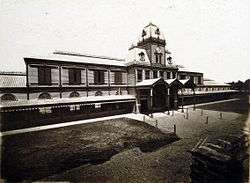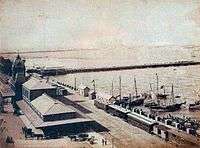Central Station (Buenos Aires)
Central Station Estación Central | |
|---|---|
| Commuter rail | |
|
Facade of the station in 1875. Photo by Christiano Junior. | |
| Location |
Av. Paseo de Julio and Piedad, Buenos Aires, Argentina |
| Owned by | BA & Ensenada |
| Line(s) | |
| Construction | |
| Platform levels | 3 |
| History | |
| Opened | 12 Aug 1872 |
| Closed | 1897 |
The Central Station (in Spanish: Estación Central) was a railway station of Buenos Aires, terminus of all the railway lines existing by then and owned by the Buenos Aires and Ensenada Port Railway. The station, located on the corner of Paseo de Julio Avenue (currently Leandro N. Alem) and Piedad street (today Bartolomé Mitre), operated from 1872 to 1897. The building was a wood structure (built in Great Britain), that had a mansard roof and a little tower with a clock and a dome on the top.
History
By August 1872 all the railway companies operating in Argentina signed an agreement for a common use of Central Station, which was owned by BA&E railway by then. The station had a platform over the main track and other two. Its structure also included two coffeehouses and two ladies rooms. Trains arrived from the South through a viaduct made of iron, that extended from Casa Amarilla station to Victoria (current Hipólito Yrigoyen) street. The route of the viaduct would be later used to build the Paseo Colón Avenue.

The building, built in wood, was brought from Great Britain by entrepreneur William Wheelwright, although it had been originally built to be used in India (then a British colony). The use of the station was shared by five railway companies, BA & Ensenada, BA Western, BA & Pacific, BA & Rosario, BA & Northern and Central Argentine.[1]

To facilitate access to Central Station, the Buenos Aires Great Southern Railway built a small joint branch from Barracas station (current Hipólito Yrigoyen) to Tres Esquinas station (owned by BA&E).
When Central Station was opened, tracks run alongside Río de la Plata. the Aduana Taylor was placed at the South. When the Port of Buenos Aires was inaugurated in 1987, BA&E's tracks blocked the lands and access to the port, therefore many people opposed to railway transit across the city of Buenos Aires. The station served as terminus not only for BA & Ensenada but for other railways such as BA Western, BA & Rosario and BA & Northern.
It was a real 'central' station, with a platform over the main line and other two for unused tracks, with a capacity for 4 or 5 trains. The first of them named "Vía Belgrano" because it was generally used for services to the city of Belgrano (...) The other one named "Four and a half track", because trains to Tigre departured at that time (4.30), being them amongst the main services of Northern Railway. Facilities for passengers existed in duplicate, on a side facilities for BAGSR passengers and on the other side, for the BAN. They don't even mingle to drink a whisky so there were two bars, two ladies' room, and so on. Facilities for employees included two post offices at both ends of the station, and, in the middle of the building, a ticket office with a passage on the North side and another on the South side for their respective services. Under one of the stairs stayed a telegraph office, and under the other stair there was a post office. In conclusion, nothing else was necessary there. Chief Inspector and his other two inspectors could use the entire platform as their offices— William Rogind [2]
On February 14, 1897, the station was completely destroyed by fire. Next day, the company built some wood shacks to sell tickets as a replacement of the destroyed station, but they were removed by the Government of the city. Railway companies existing by then (BA & Rosario, Central Argentine and BA & Pacific) had to leave the place, moving to Retiro station, where they have remained until present days.[3]
As a result, BA&E established Venezuela station as terminus, although shortly after it was moved to Casa Amarilla. On March 19 the National Government ordered to remove all tracks from Casa Amarilla to Retiro, also forbidding Central Station was reconstructed. Finally, on July 1, the line was closed.
During the 1890s the National Government considered to move the Central Station to Puerto Madero although it was never carried out.
References
- ↑ "Cuando los trenes llegaban al Bajo" by Eduardo Parise, Clarín, 6 Jul 2015
- ↑ Historia del Ferrocarril del Sud: 1861-1936, by William Rogind - Establecimiento Gráfico Argentino, Buenos Aires (1937)
- ↑ Historia del Ferrocarril al Norte del Gran Buenos Aires: Ferrocarriles Mitre y Belgrano, by Ariel Bernasconi - Editorial Dunken, Buenos Aires (2012) - ISBN 978-9870257691
| Wikimedia Commons has media related to Estación Central de Buenos Aires. |
Coordinates: 34°36′23″S 58°22′11″W / 34.6064°S 58.3698°W
